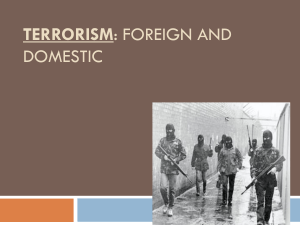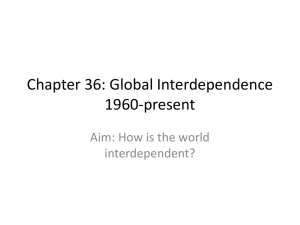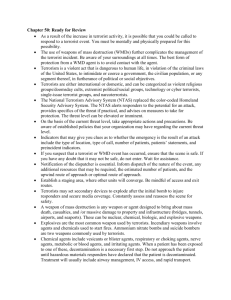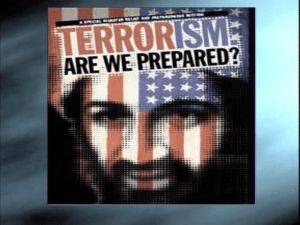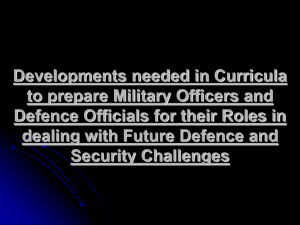Brice H. SmithScholarly Paper5 May 2011 Terrorism as a Way of
advertisement
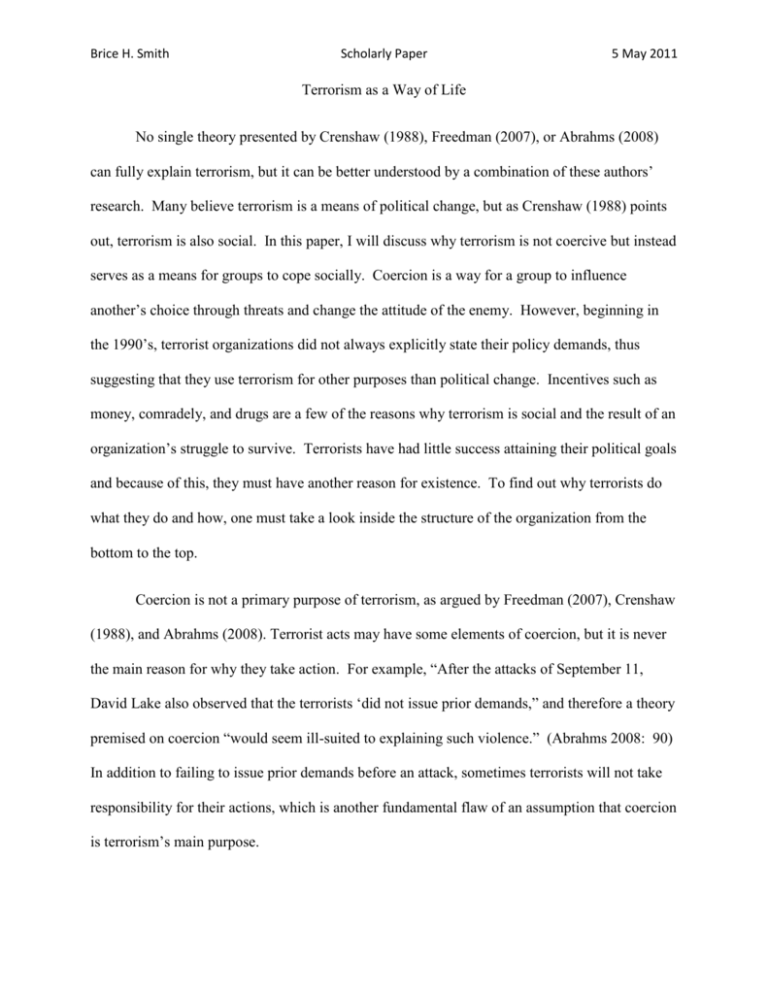
Brice H. Smith Scholarly Paper 5 May 2011 Terrorism as a Way of Life No single theory presented by Crenshaw (1988), Freedman (2007), or Abrahms (2008) can fully explain terrorism, but it can be better understood by a combination of these authors’ research. Many believe terrorism is a means of political change, but as Crenshaw (1988) points out, terrorism is also social. In this paper, I will discuss why terrorism is not coercive but instead serves as a means for groups to cope socially. Coercion is a way for a group to influence another’s choice through threats and change the attitude of the enemy. However, beginning in the 1990’s, terrorist organizations did not always explicitly state their policy demands, thus suggesting that they use terrorism for other purposes than political change. Incentives such as money, comradely, and drugs are a few of the reasons why terrorism is social and the result of an organization’s struggle to survive. Terrorists have had little success attaining their political goals and because of this, they must have another reason for existence. To find out why terrorists do what they do and how, one must take a look inside the structure of the organization from the bottom to the top. Coercion is not a primary purpose of terrorism, as argued by Freedman (2007), Crenshaw (1988), and Abrahms (2008). Terrorist acts may have some elements of coercion, but it is never the main reason for why they take action. For example, “After the attacks of September 11, David Lake also observed that the terrorists ‘did not issue prior demands,” and therefore a theory premised on coercion “would seem ill-suited to explaining such violence.” (Abrahms 2008: 90) In addition to failing to issue prior demands before an attack, sometimes terrorists will not take responsibility for their actions, which is another fundamental flaw of an assumption that coercion is terrorism’s main purpose. Brice H. Smith Scholarly Paper 5 May 2011 Crenshaw believes that coercion is a strategy used to intimidate and is based on the power to hurt but not to use military force. This is part of her conceptualization of instrumental approaches, where terrorism is supposed to represent a strategic choice. Strategic choice is not a valid theory for terrorism, but that will be explained later by an organizational theory. In What Terrorists Really Want, Abrahms discusses strategic choice and whether or not it is useful for understanding terrorism. He makes an allusion to coercion when outlining the strategic model, but soon after says terrorists’ decisions are not based on this model. “Does the terrorists’ decision making process conform to the strategic model? The answer appears to be no.” (Abrahms 2008) I agree with Abrahm’s assessment of the strategic model. After not considering this as a means for understanding terrorists’ decisions, I started to believe in the true strategy terrorists use in their decision making process which is the organizational approach. Some elements of explaining terrorism are explained by the instrumental approach, and the control and consensual strategy, but in the overall scheme of things the organizational theory is the best way to explain terrorism. Crenshaw’s (1988) essay is about the comparison between the organizational approach and the instrumental approach, but her arguments on the organizational side are similar to the arguments Abrahms (2008) makes. Before joining a terrorist organization, individual members are usually isolated. They struggle to find people to associate with because generally they are different from the majority of society. This makes recruiting very easy for terrorist organizations because they seek individuals like this. The promise of comradely, drugs, money, and people to relate to draw outsiders into terrorism because this way of life is better than anything they have ever had in the past. The leaders of these organizations use these social incentives to lure people into joining. Once a member, these individuals are trained based off of the beliefs of the leaders. Muslim terrorists, Brice H. Smith Scholarly Paper 5 May 2011 for example, are taught by their leaders the radical interpretations of the Quaran. Leaders will only tell recruits certain aspects of the Quaran because they can take the scripture out of context and use it to get the young members to believe only what they want them to believe. The recruits carry out the attacks. Many never rise through the ranks because they are often killed in suicide bombings or they are in prison. Al-Quada is an example of an organization that uses many of its young members to carry out suicide attacks. On the other hand, the IRA sees many of its younger members sent to prison. When they get out, they are at a lower status within the organization because keeping them around is very risky since they can easily be monitored by authorities. I have come to the conclusion that Abrahm’s (2008) natural systems model best explains how terrorist organizations function. This position is bolstered by clear flaws in strategicallybased theories. They state that terrorists are motivated by political and ideological goals, and they exist to create political change in the government they choose to attack. However, many times organizations struggle to survive so they act with the purpose of staying together. These actions may not conform to their official goals which create a dilemma. Because terrorists will sometimes engage in crimes that do not align to their values, one must look at the social structure to find a strategy that makes more sense. The substance of the last third of Abrahm’s (2008) essays is about the real reasons terrorists engage in their behavior. Marc Sageman studied 172 global Salafi jihadists and made some remarkable conclusions. “… 80 percent of whom are “cultural outcasts living at the margins of society” as unassimilated first or second-generation immigrants in non-Muslim countries.” (Abrahms 2008: 97) Sageman is referring to Al-Qaida and how some of them living away from their native homeland cope with their distress and find comfort in a terrorist Brice H. Smith Scholarly Paper 5 May 2011 organization. Furthermore, consider how terrorists find members to join their group. If an unrelated individual were to request joining a terrorist organization, current members of the organization would clearly be suspicious of the individual’s motives. The recruiter would wonder who this person is, why they want to be a member of a terrorist organization, whether or not they are a spy, and even if they think they want to join, how willing would they be to carry out the extreme actions that many new and young members must do. Most members join because they have family and/or friends who are part of the movement. When bombs are detonated and when sporadic attacks occur, they often result in little or no benefit to terrorist organizations. Given that terrorists want to advance their political agenda, there is little to no solid proof of them making progress. Their attacks are just to let the public know they still exist because they crave attention. Present day Afghanistan is a perfect example which shows how terrorists only desire recognition. The Taliban has taken responsibility for any incident where an American soldier has been killed or injured. However, on several occasions officials have reported no link between the attacker and the Taliban. This proves how great their desire is for recognition. Also, the death of Osama Bin Laden has raised many safety concerns. There is fear that Al-Qaida will attempt more attacks in the future to reinforce their presence. It is important for them to show others that the death of Bin Laden does not mean the “War on Terror” is over. Their potential attacks, which the C.I.A. calls inevitable, may have some tactical characteristics to them, but they will not result in long term political changes. The main reason behind these potential attacks is to let their enemies know they still exist and they can still attract the public’s attention. Abrahm’s (2008) model points to all the flaws in the strategic models system and makes reference to why the organizational model explains terrorism. The organizational model is best Brice H. Smith Scholarly Paper 5 May 2011 explained by Martha Crenshaw (1988). “The minimal goal of any organization is survival, but the goals of the people occupying roles in an organization transcend mere survival,” (Crenshaw, 1988). The leaders in an organization give incentives to those lower in the organization to keep it operating. Terrorism is about survival. The leaders of an organization may believe in a political purpose for their existence, but those under them do not. That is why they need to offer them something in order to keep the organization together. “…Terrorism becomes selfsustaining”, says Crenshaw (Crenshaw 1988). If members have a reason to stay involved (i.e. relationships, money, drugs, comradely) then they have no reason to leave. Coercion is a strategy used by terrorists but only if their goals are political. Because terrorism is best described by the organizational approach, coercion is not a means to an end for terrorists, and though it is mentioned in all three author’s work, it is not relevant. From the bottom up, terrorists are told what to believe but, they will not act on that belief if there are no incentives. Terrorism is a vicious cycle. When there are strong social ties, money, and other incentives then terrorists stay involved because it is their new way of life. The tradeoff is they must conform to the ideology of the group, thus resulting in violent actions to satisfy the leaders. As long as this continues, terrorism will be a way of life for many, and it will always exist. Brice H. Smith Scholarly Paper 5 May 2011 References 1. Abrahms, M. (2008). “What Terrorists Really Want Terrorist Motives and Counterterrorism Strategy.” International Security. The MIT Press. 32 (4), 78-105. 2. Crenshaw, M. (1988). “Theories of Terrorism: Instrumental and Organizational Approaches.” Inside Terrorist Organizations. New York City: Columbia University Press. 3. Freedman, L. (2007). “Terrorism as a Strategy.” Government and Opposition. 42 (3): 314-339.

